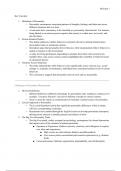McGann 1
Key Concepts
1. Definition of Personality:
○ Personality encompasses consistent patterns of thoughts, feelings, and behaviors across
different situations and over time.
○ A trait must show consistency to be classified as a personality characteristic. For instance,
being labeled as an anxious person requires that anxiety is evident now, next week, and
into the future.
2. Person-Situation Debate:
○ This debate addresses whether behavior is primarily driven by internal characteristics
(personality traits) or situational contexts.
○ Internalists argue that personality drives behavior, while situationalists believe behavior is
mainly a response to the environment.
○ A study involving participants responding to prompts about their extroversion levels
multiple times a day across various contexts highlighted the variability in behavior based
on situational factors.
3. Variation Across Situations:
○ The study indicated that while behavior varies significantly across contexts (e.g., social
settings vs. academic environments), individuals have consistent baseline levels of certain
behaviors.
○ This consistency suggests that personality traits do exist and are measurable.
Challenges in Personality Measurement
1. Diverse Definitions:
○ Different fields have different terminology for personality traits, leading to confusion. For
example, "executive function" can refer to different concepts in various contexts.
○ There’s a need for clarity in communication to facilitate a unified science of personality.
2. Lexical Approach to Personality:
○ The Lexical Hypothesis posits that significant personality differences within a culture
will have corresponding vocabulary.
○ Researchers have combed through the English lexicon to develop personality descriptors,
utilizing factor analysis to identify patterns and clusters of traits.
3. The Big Five Personality Traits:
○ The Big Five model, widely accepted in psychology, encompasses five broad dimensions
that capture most of the variation in human personality:
■ Openness to Experience: Reflects curiosity, creativity, and willingness to explore
new ideas and experiences.
■ High scorers are often abstract thinkers and philosophical.
■ Low scorers prefer conventional and concrete experiences (e.g., familiar
food).
■ Conscientiousness: Indicates organization, dependability, and self-discipline.
, McGann 2
■ High scorers have structured and meticulous lifestyles, while low scorers
may be disorganized.
■ Extraversion: Associated with sociability, assertiveness, and positive
emotionality.
■ High scorers are energized by social interactions, while low scorers may
feel drained after social engagements.
■ Agreeableness: Reflects warmth, kindness, and cooperativeness.
■ High scorers prioritize getting along with others and valuing harmony.
■ Neuroticism: Indicates emotional stability and sensitivity to negative emotions.
■ High scorers may experience anxiety and moodiness, while low scorers
are calm and easygoing.
The Adaptive Nature of Personality Traits
1. Personality Traits in Context:
○ The adaptiveness of traits like neuroticism can be context-dependent. For example, high
neuroticism may serve as a protective mechanism in risky environments.
○ The pandemic illustrated how personality traits interact with situational demands, as
highly extroverted individuals faced greater risks due to social behavior.
2. Personality Change:
○ Personality can change over time, influenced by life circumstances (e.g., new jobs or
relationships).
○ Individuals tend to retain relative rankings in personality traits compared to peers, even as
they develop over time.
3. Intentional Personality Modification:
○ People may seek to modify their personalities through various means, including therapy,
medication, or experiences like psychedelic therapy.
Personality in Animal Studies
1. Observations in Non-Human Animals:
○ Research has demonstrated that individual differences in personality traits are not unique
to humans. For example:
■ Chimpanzees showed varied reactions to novel stimuli (like a kung fu dummy),
indicating personality-like traits.
■ Puppies responded differently to environmental stressors (e.g., loud noises),
showcasing early indicators of temperament.
2. Predictive Insights from Early Behavior:
○ Studies of toddlers responding to a strange robot indicated that early reactions can predict
future personality traits. For example,
■ Toddlers who exhibited fear were more likely to become neurotic adults.




